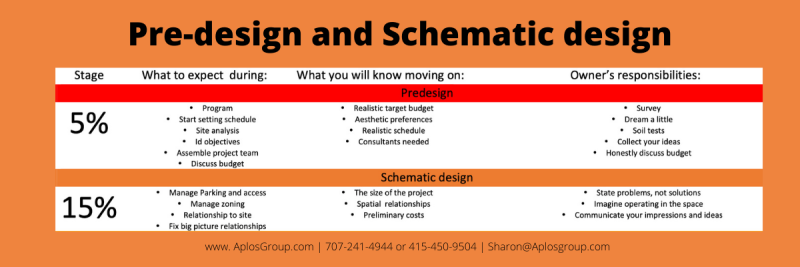1st in a series of posts on this topic
This time of year is an opportunity to take stock of the life-changing events we’ve seen or experienced in the last 12 months. It is also a time when we dream a little, maybe set some goals while thinking about the next 12 months.
A design-build project can be anything from remodeling a current room to creating an addition or designing an entirely new structure from the ground up. Depending on the scope of your project, you may need the skills of an architect.
In a recent post, we provided an overview on the topic of setting expectations when working with an architect. In this post, we’ll touch on the elements involved in the 5 stages of a design-build project. These stages vary in detail and length according to the complexity of a project but will apply whether you are envisioning a residential or commercial project.
Pre-Design
Site Assessment
A client consultation comes first to determine if your project and your chosen architect are a good fit. After that, the architect will want to gain an understanding of the existing building site conditions. Any documentation about property lines/lot size, slope, and either placement of a current structure or desired placement of new structure will be considered. A survey is necessary for an architect to determine the suitability of the site for the desired project. Measurements, photographs, and any special knowledge of site conditions like poor drainage, or tree removal restrictions that may impact the project are all part of this process.
Zoning Requirements and Restrictions
Code requirements loom large, depending on the municipality governing building codes. Other things that can affect any new development on a site include changing climate conditions that have triggered tougher environmental restrictions. Think building lots located near waterways. In Marin County, the drought is pushing entities like Marin Municipal Water District to consider implementing new rules and fees regarding the development of new housing.
Development of a Preliminary Budget
Your architect will encourage you to bring your dreams and ideas to the table. At this stage it is important to examine them for both their design feasibility and how realistically they will fit into your budget.
Start a Tentative Schedule
This pre-design phase includes documenting the ideas, conditions, restrictions and possibilities that exist for a certain site and design. A tentative schedule can be started for things like approval of the drawings, any interaction with the zoning agencies to determine feasibility, and the identification of any team members who might be involved in the project.
Schematic Design
The site assessment process culminates in the creation of a basic 2D rendering of your design project which allows you to see features, like windows, doors, corridors and room placements and dimensions, that show an outline of the project.
This is a good time to discuss whether what you envisioned for the project is captured in the drawings. Will the size and scope of the new space fit the uses you plan for it? Are there adjustments needed? Is it within your budget? This is the time for you to be very involved and contribute your feedback, so the architect gathers as much accurate information as possible to create a simple representation of your project before deciding on next steps.
Stay tuned – for the next post in this series, Design Development.


